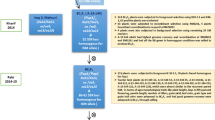Abstract
MTU 1010 is a high-yielding mega-variety of rice grown extensively in India. However, it does not perform well in soils with low phosphorus (P) levels. With an objective to improve MTU 1010 for tolerance to low soil P, we have transferred Pup1, a major quantitative trait locus (QTL) associated with tolerance from another mega-variety, Swarna, through marker-assisted backcross breeding (MABB). Foreground selection of the F1 and backcross plants was performed with the co-dominant, closely linked CAPS marker, K20-2, while two flanking markers RM28011 and RM28157 were utilized for recombinant selection. At each backcross generation, positive plants were also analyzed with a set of 85 parental polymorphic SSR markers to identify the QTL-positive plants possessing maximum introgression of MTU 1010 genome. At BC2F1, the best backcross plant was selfed to generate BC2F2s. Among them, the plants homozygous for Pup1 (n = 22) were reconfirmed using the functional marker for Pup1, viz., K46-1, and they were advanced through pedigree method of selection until BC2F6 generation. A total of five elite BC2F6 lines, possessing Pup1 and phenotypically similar to MTU 1010, were screened in the low soil P plot and normal plot (with optimum soil P levels) during wet season, 2016. All the selected lines showed better performance under low P soil with more number of productive tillers, better root system architecture, and significantly higher yield (> 390%) as compared to MTU 1010. Further, under normal soil, the lines were observed to be similar to or better than MTU 1010 for most of the agro-morphological traits and yield. This study represents the successful application of marker-assisted selection for improvement of tolerance to low soil P in a high-yielding Indian rice variety.



Similar content being viewed by others
References
Phil Aaker, Mark Carroll, Joe Conn, Michael Morris, Brian Morrison, Dan Nagengast, Dick Walker, and Lee White. 1980. Training and development of rice production. Peace Corps. Chapter-8
Chin JH, Gamuyao R, Dalid C, Bustamam M, Prasetiyono J, Moeljopawiro S, Wissuwa M, Heuer S (2011) Developing rice with high yield under phosphorus deficiency: Pup1 sequence to application1. Plant Physiol 156(3):1202–1216
Dobermann A, Fairhurst T. (2000). Rice: Nutrient disorders & nutrient management
Fageria NK, Wright RJ, Baligar VC (1998) Rice cultivar evaluation for phosphorus use efficiency. Plant Soil 111:105–109
Gamuyao R, Chin HJ, Tanaka JP, Pesaresi P, Catausan S, Dalid C, Loedin SI, Mendoza TME, Wissuwa M, Heuer S (2012) The protein kinase Pstol1 from traditional rice confers tolerance of phosphorus deficiency. Nature 88:535–541
Heuer S, Lu X, Chin JH, Tanaka JP, Kanamori H, Matsumoto T, De Leon T, Ulat VJ, Ismail AM, Yano M (2009) Comparative sequence analyses of the major quantitative trait locus phosphorus uptake 1 (Pup1) reveal a complex genetic structure. Plant Biotechnol J 7:456–457
Huang CY, Roessner U, Eickmeier I, Genc Y, Callahan DL, Shirley N, Langridge P, Bacic A (2008) Metabolite profiling reveals distinct changes in carbon and nitrogen metabolism in phosphate-deficiency barley plants ( Hordeum vulgare L.). Plant Cell Physiol 49:691–703. https://doi.org/10.1093/pcp/pcn044
Olsen, S.R., C.V. Cole, F.S. Watanabe, and L.A. Dean. 1954. Estimation of available phosphorus in soils by extraction with sodium bicarbonate. U.S. Dep. of Agric. Circ. 939
Pandit E, Sahoo A, Panda RK, Mohanty DP, Pani DR, Anandan A, Pradhan SK (2016) Survey of rice cultivars and landraces of upland ecology for phosphorous uptake 1 (Pup1) QTL using linked and gene specific molecular markers. Oryza 53:1–9
Pariasca-Tanaka J, Chin JH, Dramé KN, Dalid C, Heuer S, Wissuwa M (2014) A novel allele of the P-starvation tolerance gene OsPSTOL1 from African rice (Oryza glaberrima Steud) and its distribution in the genus Oryza. Theor Appl Genet 127(6):1387–1398
Sarkar S, Yelne R, Chatterjee M, Das P, Debnath S, Chakraborty A et al (2011) Screening of phosphorus tolerance and validation of Pup 1 linked markers in Indica rice. Ind J Genet Plant Breed 71:209–213
Sheehy JE, ADionora MJ, LMitchell P (2001) Spikelet numbers, sink size and potential yield in rice. Field Crop Res 71:77–85
Steen I (1998) Phosphorous availability in the 21st century: management of a non-renewable resource. Phosphorous and potassium 217:25–31
Sundaram RM, Vishnupriya MR, Biradar SK, Laha GS, Reddy AG, Rani NS, Sarma NP, Sonti RV (2008) Marker assisted introgression of bacterial blight resistance in Samba Mahsuri, an elite indica rice variety. Euphytica 160:411–422
Vance CP, Uhde-Stone C, Allan DL (2003) Phosphorus acquisition and use critical adaptations by plants for securing a non-renewable resource. New Phytol 157:423–447
Veronica N, Subrahmanyam D, Vishnu Kiran T, Yugandhar P, Bhadana VP, Padma V, Jayasree G, Voleti SR (2017) Influence of low phosphorus concentration on leaf photosynthetic characteristics and antioxidant response of rice genotypes. Photosynthetica 55:285–293
Wissuwa M, Yano M, Ae N (1998) Mapping of QTLs for phosphorus deficiency tolerance in rice (Oryzasativa L.). Theor Appl Genet 97:777–783
Wissuwa M, Wegner J, Ae N, Yano M (2002) Substitution mapping of Pup1: a major QTL increasing phosphorus uptake of rice from a phosphorusdeficient soil. Theor Appl Genet 105:890–897
Yano M, Kojima S, Takahashi Y, Lin H, Sasaki T (2001) Genetic control of flowering time in rice, a short-day plant. Plant Physiol 127:1425–1429
Zheng K, Huang N, Bennett J, Khush GS. (1995). PCR-based marker assisted selection in rice breeding. International Rice Research Institute, Manila, the Philippine, IRRI, Discussion Paper Series No. 12
Acknowledgments
The authors thank the Director, ICAR-Indian Institute of Rice Research, for providing all the necessary facilities.
Funding
The authors received financial support provided by the Department of Biotechnology (DBT), Government of India, for execution of the research study through the Grant # BT/PR4665/AGII/106/854/2012 dated: 19/02/2013.
Author information
Authors and Affiliations
Corresponding author
Rights and permissions
About this article
Cite this article
Anila, M., Mahadeva Swamy, H.K., Kale, R.R. et al. Breeding lines of the Indian mega-rice variety, MTU 1010, possessing protein kinase OsPSTOL (Pup1), show better root system architecture and higher yield in soils with low phosphorus. Mol Breeding 38, 147 (2018). https://doi.org/10.1007/s11032-018-0903-1
Received:
Accepted:
Published:
DOI: https://doi.org/10.1007/s11032-018-0903-1




